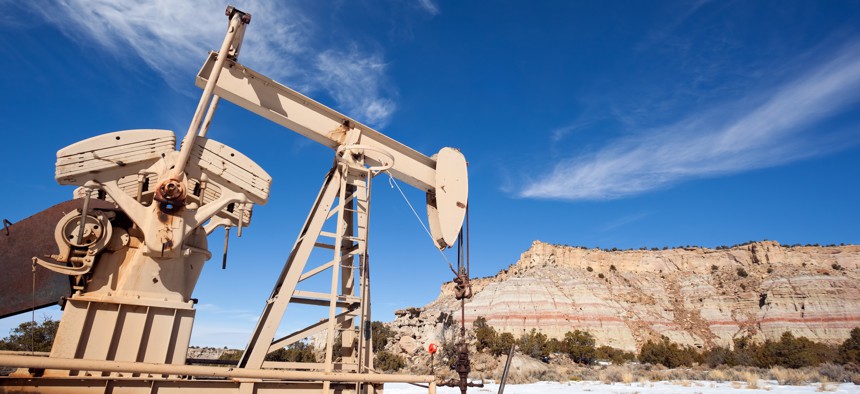Energy-Producing States Lag in Latest Economic Numbers

An oil drill in New Mexico. Amygdala_Imagery via Gett Images
Energy companies, short of workers, aren’t ready to increase production.
This story was originally posted by Stateline, an initiative of the Pew Charitable Trusts.
Amid worries about a possible recession, energy-producing states had the biggest drops in GDP during the first quarter of this year, despite skyrocketing oil and gas prices, new government figures show.
The main reason: Energy companies are still struggling to bring back workers and rigs that were idled early in the pandemic.
GDP, or gross domestic product, is a measure of economic output. The unofficial definition of a recession is when GDP drops for two consecutive quarters. However, a recession is generally accompanied by a significant rise in the unemployment rate, and U.S. employment remains strong. Labor Department figures released Friday show the economy added 372,000 jobs in June, a larger-than-expected increase. No state has seen a significant spike in joblessness.
The states with the largest declines in GDP so far this year, however, are heavy oil, gas and coal producers: Alaska, Louisiana, Montana, New Mexico, North Dakota, Oklahoma, West Virginia and Wyoming all registered decreases of between 4% and 10% in GDP.
In addition to labor shortages, energy companies are grappling with supply chain issues and are wary of investing in more production as the United States works to move away from its reliance on fossil fuels, according to Wenlin Liu, chief economist in Wyoming’s state Economic Analysis Division. Wyoming had the largest drop in GDP.
“There are many reasons for their slow response to the increasing and high prices, from supply chain restraint, labor force shortages, investor pressure, regulation concerns to uncertainty about the future in terms of climate change regulation,” Liu said.
States with large energy sectors are raking in more tax revenue thanks to the higher prices. But like people in the rest of the country, residents of energy-producing states are struggling to afford the rising cost of filling up their cars and air-conditioning their homes.
“These are dire times for Alaskans who are paying at the pump while the government benefits from high oil prices,” said Alaska Republican Gov. Mike Dunleavy in a May statement asking for larger oil revenue disbursements for state residents.
In Alaska, where gas prices in rural areas can hit $16 a gallon because it has to be delivered by air or barge, the effect is especially severe. The legislature set the annual revenue disbursement in October at about $3,200, a big increase from last year’s $1,100 but not as much as the governor wanted, spokesperson Jeff Turner said.
The few states where GDP increased during the first quarter were mostly in New England. Economic activity increased in New Hampshire (up 1.2%), Vermont (0.7%) and Massachusetts (0.2%). Michigan also saw a small uptick (0.1%). Increased government spending was the most important factor in New Hampshire, Massachusetts and the New England region generally.
Nationwide there was a 1.6% drop in GDP for the first quarter. An Atlanta Federal Reserve Bank indicator points to another drop of 1.9% for the second quarter that ended last month. Any decision to call a recession falls to the National Bureau of Economic Research, which defines it as “a significant decline in economic activity that is spread across the economy and lasts more than a few months.”
Despite high profit potential, energy companies are competing with other industries for skilled workers to ramp up supply as demand for gas returns, said Cindy B. Taylor, CEO of Oil States International, a provider of infrastructure for energy companies, speaking in May at a Federal Reserve Bank of Minneapolis event.
“This is hard work, hourly work, and 40-50% of our workers were let go in 2020,” Taylor said. “This downturn lasted too long, and we permanently lost a lot of workers.”
Wyoming’s energy industry, like Alaska’s, generated more revenue because of higher prices despite a drop in oil production of 4% and a drop in natural gas production of 7% from the previous quarter, Liu said.
North Dakota energy companies also are having trouble finding enough workers, said David Flynn, an economics professor at the University of North Dakota. Meanwhile, residents and businesses there are “feeling the bite of higher inflation like other places,” Flynn said. “The cost of filling the gas tank, the other prices of production, these are all concerns for individuals and businesses.”
Some experts see more oil production coming online in the coming months, helping to ease gasoline prices and add to GDP.
“There’s just too much money to be made at these oil prices” to keep production from ramping up, said Jason Bordoff, dean of the Columbia Climate School in New York City, speaking at the Minneapolis Fed event in May. He said losses over the past decade, when oil prices dipped, made many investors shy about upping production initially.
“We need to increase supply today to keep energy affordable and secure. But in the future, we want a different energy system,” Bordoff said. “So policymakers are threading a needle here. We don’t want to make it harder to get to our climate goals later.”
NEXT STORY: Virtual Meetings Stymie Creative Teamwork





